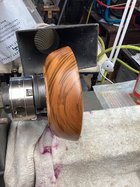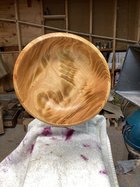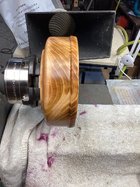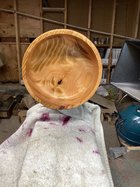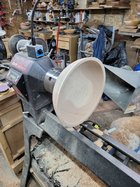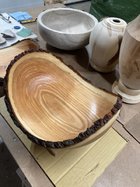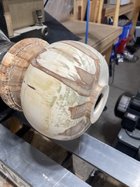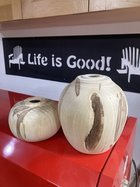-
Congratulations to Bob Henrickson, People's Choice in the November 2025 Turning Challenge (click here for details) -
Congratulations to Dave Roberts for "Low Rider" being selected as Turning of the Week for December 1, 2025 (click here for details) -
Welcome new registering member. Your username must be your real First and Last name (for example: John Doe). "Screen names" and "handles" are not allowed and your registration will be deleted if you don't use your real name. Also, do not use all caps nor all lower case.
You are using an out of date browser. It may not display this or other websites correctly.
You should upgrade or use an alternative browser.
You should upgrade or use an alternative browser.
What’s on your lathe?
- Thread starter Rusty Nesmith
- Start date
Odie
Panning for Montana gold, with Betsy, the mule!
Update on the Bimblebox burl bowl with the huge void. Looks like I might getAlso, brought to round an Australian Bimblebox burl bowl. Some of you may remember this one, as there was a thread discussing it. When I initially roughed it out, a very big void appeared that was a complete surprise to me.I've decided to finish it up and keep that void.....we'll see how it turns out.....fingers crossed on this one! Bottom of bowl will have to be extra thick, so as not to punch through on both sides. As usual with many of these exotic woods, I'll have to deal with other scattered cracks, bark inclusions, and voids in this one. Comments welcome.
View attachment 56737 View attachment 56738
something usable out of this after all. Still have to do the foot, and that will be
about two weeks from now. As you can see in the interior, I'm just breaking
through to the big void, so I left the depth of the interior there. It's approximately'
3/4" thick there, but I figured it looks better at this thickness, than if I had gone
thinner. As a result, the bowl will be fairly heavy, relative to it's size.


Last edited:
2 cherry bowls, unsure if ornamental or wild from a friends place. The rounds had pp beetles plus ants so baked both in a toaster oven for 6 hours at 140F. Bowl 1 blank was baked first then turned and finished while #2 was turned, sanded to 600g then baked. There was slight distortion after baking the finished bowl but the wood was quite dry when turned.
Attachments
Phil, I have been having fun making finials for a while. When I first started I used a “Finial Chucky” made by rubber Chucky. That made it easier to make a point on the end. Probably what helped me the most was watching Cindy Drozda videos. You are doing well, but one thing that might make it a bit easier is to get the top of the finial as thin as you want it before removing wood more towards the bottom. Once you move on you can’t go back, except for some light sanding.
It has the right coloring for butternut but I have never seen a butternut burl. Butternut also is very soft and open grained so maybe?Starting on a piece of what I was told is a cherry burl. Somehow that doesnt look right for that. Almost looks like a mahogany, quilted or burl. Any guesses? It developed very good chatoyance as evidenced by this picture.
View attachment 57134
Ive turned butternut, its coarse grained and stringy as well as having a blonde character. This is fine grained, pretty hard and pretty brown tones.
Gary, first look at that bowl, and I thought it was California Bay Laurel/Oregon Myrtle wood. The color is about right for a lot of the myrtle we get here. It does tend to have a kind of sweet spicy smell to it. If it is starting to rot, it can smell like a horse stall.... It is one of those woods that the higher grit you sand to, the more it glows.
robo hippy
robo hippy
My wife wanted a tabletop for this plant stand. I could have done it with dimensional lumber but I wanted to turn it. One of my mulberry logs was just big enough to turn a 12" side grain plate. Getting a thinnish, 12" plate flat was not as easy as you might think (at least for me).

Tom Gall
TOTW Team
Interesting pentagon shape! Turned or machined with a router? I assume that chain doesn't have anything to do with the bowl.
It occurs to me that piece of hophornbeam looks an awful lot like osage orange. I used an app to identify the tree before I cut it down but now I'm not sure.
Yes I thought it had to be something other then Hop Hornbeam because I was just turning some wooden bolts in American hornbeam or as the locals call it "iron wood" and that is not a ring porous wood. The sapwood is very white and dense/hard and the heart wood is a dull brown and not as hard.It occurs to me that piece of hophornbeam looks an awful lot like osage orange. I used an app to identify the tree before I cut it down but now I'm not sure.
 I just started to make wooden bolts to mount my grandfathers Remington Arms Company 1889 SXS shot gun on my wall. The mounting will consist of a two piece wooden clamp for the stock and for the barrel held together by 1/2" - 8threaded bolt with a 7/8" hex head. The first picture is sizing the blank at 1" diameter for the head then the next step will be to mount the blanks in my Beal Jumbo chuck with 1" collet to turn the 1/2" dia for threading.
I just started to make wooden bolts to mount my grandfathers Remington Arms Company 1889 SXS shot gun on my wall. The mounting will consist of a two piece wooden clamp for the stock and for the barrel held together by 1/2" - 8threaded bolt with a 7/8" hex head. The first picture is sizing the blank at 1" diameter for the head then the next step will be to mount the blanks in my Beal Jumbo chuck with 1" collet to turn the 1/2" dia for threading.I have one piece of Eastern Hop Horn Beam. I picked it up from a 2 time president of the International Wood Collectors Society. It is pretty much white with a slightly darker heart wood. It came from Vienna, Virginia. They put a postage sticker on it dated 7/16/93 and just mailed the blank..... Guess the sender wasn't worried about it getting damaged in transit.... Other than that, I wouldn't know a hop horn beam if it fell on me....
robo hippy
robo hippy
Looks like pecan. The bark's not rough and thick enough for osage orange.Now I have no idea what it is. Guesses? Ignore the two on the right in the first picture. With that hole down through the center it isn't osage orange.
Finished NEB of honey locust with Tried and True. Turned some hollow forms yesterday and today using some horse chestnut, Not really happy with sanding going to let them dry and give them another go. Not sure what finish to use on them.
Attachments
I'm not sure what you got there Kent, but I do have pictures of Hornbeam, aka Blue Beech, muscle wood or Iron wood, and Hop Hornbeam also know as Iron wood.Now I have no idea what it is. Guesses? Ignore the two on the right in the first picture. With that hole down through the center it isn't osage orange.
View attachment 57208View attachment 57209
There are many of these smaller trees mostly, on my sons property and I made some pictures of them there, typical Hop Hornbeam have these loose strips bark the Hornbeam has blueish smooth bark.
The wild Turkeys like the Hop Hornbeam seeds and come by with the whole flock picking as they go.




- Joined
- Feb 28, 2021
- Messages
- 1,753
- Likes
- 1,571
- Location
- Roulette, PA
- Website
- www.reallyruralwoodworks.com
Interesting.. It is the one on the left (the blue-ish grey smooth bark) that I know locally as Ironwood , Can't say I have noticed any other trees referred to as Ironwood, until I joined AAW and find that some species names may vary by region (Desert Ironwood, for example) The one on the right I presume is the one that drops those seeds turkey love so much , so I'm fairly sure we had a few such trees on the farm, but I can't say as I recall anyone mentioning what the tree was... Just seemed like Turkeys preferred to flock around those particular trees.....I'm not sure what you got there Kent, but I do have pictures of Hornbeam, aka Blue Beech, muscle wood or Iron wood, and Hop Hornbeam also know as Iron wood.
View attachment 57246
I'm not sure what you got there Kent, but I do have pictures of Hornbeam, aka Blue Beech, muscle wood or Iron wood, and Hop Hornbeam also know as Iron wood.
There are many of these smaller trees mostly, on my sons property and I made some pictures of them there, typical Hop Hornbeam have these loose strips bark the Hornbeam has blueish smooth bark.
The wild Turkeys like the Hop Hornbeam seeds and come by with the whole flock picking as they go.
I wonder if it could be honey locust. This tree was about 10 feet from a large honey locust. It was 12 years old according to ring identification. It's definitely not hornbeam as I originally thought (tricked by Picture This app). I cut down a smaller hornbeam and it has the wide, pale sapwood and dark heartwood.
Have you seen a hungry squirrel feeding on the seeds? Quite a show!I'm not sure what you got there Kent, but I do have pictures of Hornbeam, aka Blue Beech, muscle wood or Iron wood, and Hop Hornbeam also know as Iron wood.
There are many of these smaller trees mostly, on my sons property and I made some pictures of them there, typical Hop Hornbeam have these loose strips bark the Hornbeam has blueish smooth bark.
The wild Turkeys like the Hop Hornbeam seeds and come by with the whole flock picking as they go.
View attachment 57246View attachment 57247View attachment 57248View attachment 57249
The first 2 pictures showing the bark with a slight twist to the pattern are exactly what I look for when harvesting iron wood. The trees that I get are not as big as those appear to be but the wood is excellent for hand screws or wooden bolts.I'm not sure what you got there Kent, but I do have pictures of Hornbeam, aka Blue Beech, muscle wood or Iron wood, and Hop Hornbeam also know as Iron wood.
There are many of these smaller trees mostly, on my sons property and I made some pictures of them there, typical Hop Hornbeam have these loose strips bark the Hornbeam has blueish smooth bark.
The wild Turkeys like the Hop Hornbeam seeds and come by with the whole flock picking as they go.
View attachment 57246View attachment 57247View attachment 57248View attachment 57249

This hand screw has maple jaws and hornbeam/iron wood screws, the handle area was built up with walnut so that the turning blanks could use less iron wood.
My app suggests, from left to right, flowering dogwood, hophornbeam, and white oak.Now I have no idea what it is. Guesses? Ignore the two on the right in the first picture. With that hole down through the center it isn't osage orange.
View attachment 57208View attachment 57209
I think the middle-sized one with the darker heartwood is the hophornbeam (which is what you said). The left, larger tree is the one I'm wondering about. It isn't dogwood, though. Dogwood has almost a white sapwood, very little heartwood, and tight grained. The smallest tree laying under the others is a dogwood.
I made more close-ups from the pictures, I don't know what tree this is, all kinds of leafs around like Oak leavesI think the middle-sized one with the darker heartwood is the hophornbeam (which is what you said). The left, larger tree is the one I'm wondering about. It isn't dogwood, though. Dogwood has almost a white sapwood, very little heartwood, and tight grained. The smallest tree laying under the others is a dogwood.

Then the two other pieces are here, the one on the right could be OAK ??, but I don't know.




